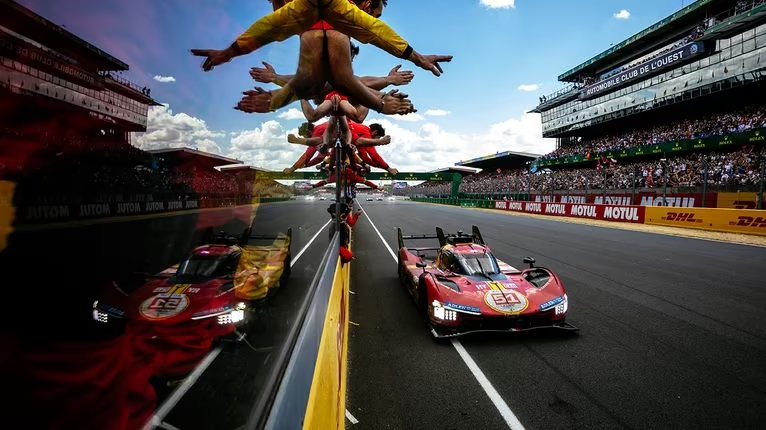Why the 24 Hours of Le Mans is a race you should watch and follow this year
- Vyas Ponnuri

- Jun 14, 2024
- 6 min read
Updated: Jul 8
Written by Vyas Ponnuri
In just under 24 hours, 186 racers are set to take to the Circuit de la Sarthe, with only one goal in sight: Win the 24 Hours of Le Mans, and etch your name in the long list of illustrious racers to have won around this staggering 13.6 km (8.4 mi) circuit.

It’s not just any race, it’s the ultimate motor race on earth. A race that tests drivers and machinery right to the limit, and often arouses raw emotions from the drivers, be it ecstasy, delight, or even heartbreak, as Toyota would experience back in 2016, 23 hours and 57 minutes into the race.
The 24 Hours of Le Mans is the race everyone wants to win. There’s no doubt. No bigger glory in racing than winning the grandest endurance race on earth. Withstand the elements and the competition for a span of 24 hours, before taking the chequered flag to win.
During these 24 hours, drivers have to go through all the eventualities of a regular motor race, facing fatigue, dehydration, tyre wear, close calls while lapping other cars, and battling their fellow racers for victory. The pit crew have to be on point, too, fuelling the car up without losing too much time, whilst having the right driver in the car at the right time.
The challenge is taken up a notch around the historic Circuit de la Sarthe, though. The biggest factor in making the 24 Hours of Le Mans what it is today are the traits of this French circuit, and you’d be mistaken if you think it’s a stroll in the park.
This 13.6 km behemoth sitting in the French town of Le Mans dwarfs many other circuits on the basis of its length alone, being the third longest active racetrack today. Only the Nurburgring Nordschleife and the Isle of Man have a longer layout than the Circuit de la Sarthe, and the latter is primarily known for its famous bike race, one of the most dangerous races to have ever taken place on earth.
But let’s talk about the Circuit de la Sarthe, though. It is twice as long as any other circuit on the endurance racing calendar, and a large section of the track is made up of straights, with one straight being as long as 6 km (3.7 mi) earlier without any chicanes or turns.
Known in common parlance as the Mulsanne straight, this section begins after the right-hander at Tertre Rouge, and runs all the way up until the Virage de Mulsanne, the drivers spending more than half the lap at full throttle.
In the past, this section was one stretch of speed without any turns in between, as drivers often clocked staggering speeds in excess of 360 km/h back in the 1970s and 1980s. Welter Racing even successfully smashed the 400 km/h barrier back in 1988, their car exceptionally fast in a straight line.
However, the high speeds and downforce generated did bring concerns, with drivers even losing their lives on this long straight. Thus, two chicanes were introduced along the straight in 1990, according to FIA’s revised guidelines stating the maximum length of a straight should be no longer than 2 km (1.2 mi).
Even still, there’s no doubt the trio of straights will stress-test the engines right to the peaks of engine reliability, and teams will have to develop their powertrains to outlast 24 hours of running at high speeds. A fascinating challenge in the modern era of racing too.
The drivers in the race cars will have to be extremely fit and focused, in order to keep the car pointing in a straight line for the entire race. Even a tiny correction at the steering wheel, or a moment of oversteer can send the car into the barriers, and leave the mechanics with a hefty repair job to do, scuppering their chances of winning Le Mans.
Being a semi-permanent facility, parts of the track are also used as main roads for the city on other days, meaning the surface isn’t as smooth as you would see on any permanent road course. The bumpy nature of the circuit can easily catch drivers out, if they’re not aware, or suddenly go off the racing line.

The challenges at Le Mans are exacerbated by the transitions from day to night, and once again from night time to daylight on the Sunday of the race. Racing at night brings its own perils and pitfalls, as the drivers have to rely on their spatial awareness and the immediate patch of road ahead to keep motoring.
They will have to keep their eyes glued to the road, and continue racing around a circuit where visibility reduces at night, and the lamp posts around the track can only illuminate the track by so much.
As last year’s running of the event showed, travails lie at every stretch of track in the night, as the #66 Ferrari crashed on the run to Tertre Rouge, leaving a four-car pile-up in its wake, including the #7 Toyota hypercar fighting for victory, caught out in the incident.
The #50 Ferrari and the #94 Peugeot too would suffer accidents at the chicanes along the Mulsanne straight, highlighting just how difficult it was for drivers to take on this fearsome track at night.

Before the stages run in darkness, however, was a downpour that saw the track go from being a smooth surface to a sodden nightmare, as multiple cars aquaplaned at the Porsche curves last year, with drivers caught out by the changing weather conditions and unable to keep their cars on track. Inclement weather is forecast for this year’s race, so this is one factor you must keep an eye on, for sure.
The challenging transition from night to day can also be just as treacherous for the drivers, who, after getting acclimated to racing in the darkness, will now suddenly find the sun in their eyes as they race, and this can cause a loss in concentration.

Now that we’ve delved into the elements and the changing times of day, there’s another factor that adds to the daunting challenge of Le Mans — drivers battling for outright victory in all three classes of cars at the track.
This is even more evident in the bustling hypercar class, with more manufacturers taking to the series in the last few years, and opening up the battle for victory. The previous running of the 24 Hours of Le Mans saw an exciting battle between stalwarts Toyota and the returning Ferrari team, with the #51 Ferrari and the #8 Toyota scrapped it out for outright victory.
If anything is to go by the grid order for Sunday, and the nature of the 2024 WEC season, we are in for a treat, with as many as four different manufacturers set to start in the top five on Saturday.
The battles stretch on to the LMP2 and the lower sportscar classes, the LMGT3 this year. Inter Europol Competition overcoming the likes of WRT to win in LMP2 in 2023, while Corvette Racing won the battle of the sports cars in the erstwhile LMGTE Am class in 2023, a class featuring the all-female Iron Dames Porsche, and the Project 1 ‘Rexy’ Porsche with a T-Rex inspired nose.

The 24 Hours of Le Mans is also a race for feel-good moments as well as tension and heartbreak, the latter being true for Toyota at the 2016 24 Hours of Le Mans, as their lead LMP1 trundled to a halt on the final lap, giving victory to a jubilant Porsche.
The circuit has seen plenty of feel-good stories, including Ford famously winning out in a popular duel against Ferrari in 1966, or the Sauber C9 triumphing at Le Mans in 1989, the last year of the circuit running the full length of the Mulsanne straight. There’s also the story of the rotary wankel-powered Mazda 787B taking victory in 1991, the last time a car with such an engine configuration managed to win the prestigious race.
McLaren would also famously triumph in the grand endurance race for the first time in 1995, in a modified McLaren F1 GTR, while Ferrari’s comeback victory in 2023 certainly won the hearts of many watching the race, as they ended a long-standing Toyota domination over the event.
These are just a few reasons why you should watch the 24 Hours of Le Mans. Do make sure to tune in to another exciting race in store on Saturday, 15th June, at 4pm CET, when the race officially gets underway.














Comments